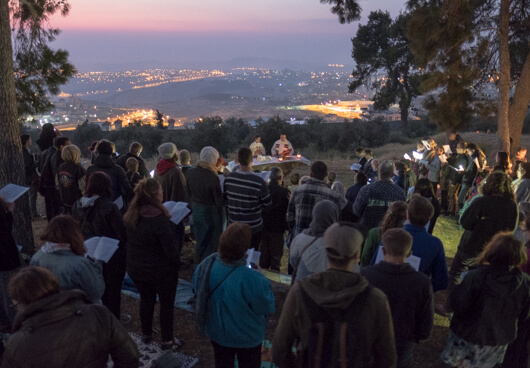It began in the stillness of night, an hour before dawn. Illuminated by only a few flecks of starlight, the Mount of Olives and its surrounding villages had merged into a sea of darkness under the tranquil night sky. As part of the little worship band that would play music for the Easter sunrise worship service on top of this mountain east of Jerusalem, I set my violin case down on the dewy lawn, took out my instrument and began harmonizing with the quiet, meditative hymns as the congregation trickled into the amphitheater.
For the myriad Christian pilgrims who journey from places all over the world to celebrate the Paschal Triduum of Holy Thursday, Good Friday and Easter in the Holy Land, Jerusalem is the city of the glorious resurrection, the place from which Christ’s promise of redemption emanates.

But as a student learning about and living firsthand Jerusalem’s active religious and political conflicts for the past three months, I found the darkness and silence of the hour before dawn on Easter Sunday more fitting than the day itself. Modern Jerusalem is a place more attuned to the divine silence of Holy Saturday, a day that does not see the sunrise of the resurrection.
It is a place marked by the silence that loomed over the earth when the Incarnation of God lay dead in a tomb. A place where the presence of God is ever so near but infinitely distant. It is the place where I, for the first time in my life, witnessed religions — including my own Catholic faith — come together not to build peace but to justify oppression using the language of religious ideology and divine will. Here people have inverted Jesus’ words, “I was a stranger and you welcomed me,” by building walls rather than opening doors. In this place marked by more injustice than peace, the beautiful hymns praising Christ and celebrating the triumphant hope and glory of Easter, interspersed with the readings and the homily, seemed disjunct from the city beyond our outdoor church.
Yet as the Eucharistic host was lifted and consecrated, a blood-red sun emerged from behind the clouds over the altar. Glancing up from my music stand to gaze at the luminous horizon for the first time, I realized that what I was looking at weren’t the landmarks of the Old City featured on the front of every Jerusalem pilgrimage brochure, but instead were the hills of residential East Jerusalem, both its Palestinian villages and its Israeli settlements. In the light of the rising sun and the Eucharist, these radiated morning light and the glory of the resurrection.
Here in Jerusalem, the resurrected Christ lives in and amongst the people, the conflicts and the lived experiences of injustice. The sacred experiences of walking on the streets where Jesus walked and celebrating Easter atop the mountain associated with Jesus’ triumphant entry into Jerusalem and his agony in the garden before his crucifixion are made complete in their convergence with the socio-political reality of today’s Holy Land. To worship at dawn in view of the austere, concrete wall between Bethlehem and Jerusalem transforms Easter and the crux of my Christian faith from a purely spiritual, disembodied experience to a faith that may only manifest itself in justice and love.
In this sense, Jerusalem truly is the land of Easter, calling Christians forth from the worship and adoration of Christ in the sacraments into solidarity with Christ in the oppressed and the persecuted. In the words of the Easter Sunday Mass entrance antiphon, Resurrexi, et adhuc tecum sum. “I am risen, and behold I am with you.”
Flora Tang is a junior political science and theology major from Beijing who is studying at Notre Dame’s Jerusalem Global Gateway during the spring semester.